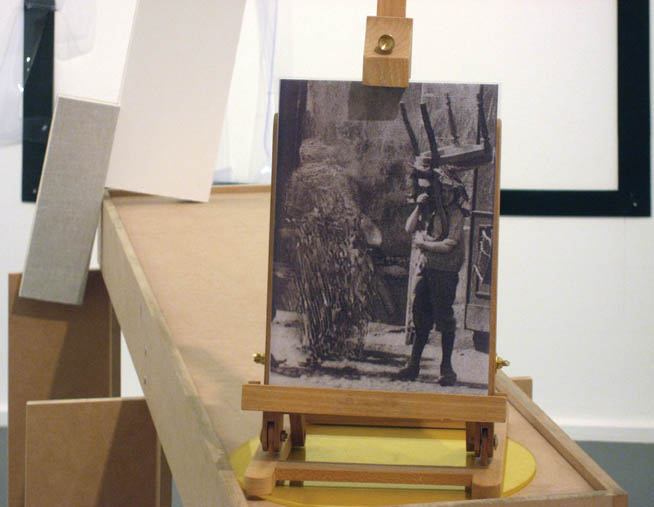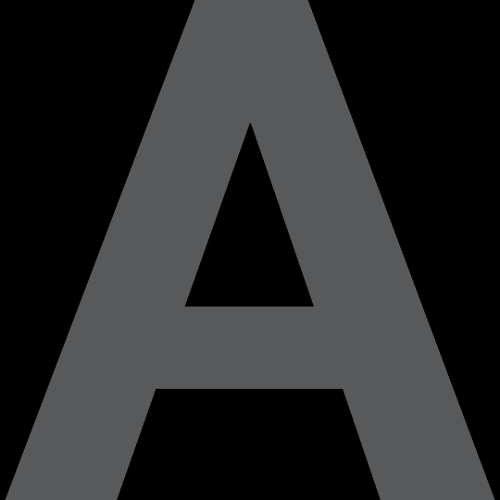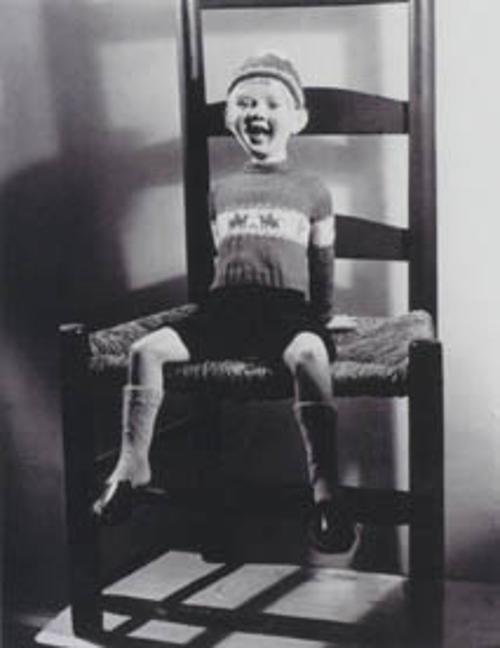
Music frames both entrances and exits in the third chapter of George Popperwell's Holocaust Trilogy: a project (a preoccupation) spanning eighteen years and apparently concluded in this series of interrelated installations.
Entering the gallery, a soundtrack (children at play, chanting German voices, rhythmic and at times errant percussion): Carl Orff's Schulwerk (School Work), plays, muffled and ambiguous, from the back rooms. The music infects and interrupts the initial encounter with a substantial body of sculptural work&singular pieces that seem to overfill their housing (appropriate given the loaded and difficult evocations they trigger). Initially, I moved quickly past them, drawn by the music toward the central installation, viewable only through a small - Duchampian - hole in a screening wall. Inside, an array of Minimalist objects surround a central sculptural support for a tiny easel which bears a sepia 'street' photograph: its image, a man holding a chair aloft, as if in self-protection against a threatening blemish in the foreground. Standing as voyeur to this cloistered space (the breeze of an unruly air-conditioning system blowing uncomfortably yet seductively into my blinking, rebuffed gaze) I felt strangely moved by this curious assemblage... a testament to simple, inexplicably incongruous acts of resistance?
Moving toward the back gallery, lured by the pull of the music, a further presentation of small street photographs interrupts, slowing down direct passage between installations. Tilted Oswiecem Late July 2007, this work documents the simplest (smallest), most comfortably familiar of pedestrian occupations. 'Pair walking, Two men talking, Pushing babies'& At the end of the hall, the back gallery is entered as a constriction of lived space, an extension of the ordinary hallway lined with handrails directing a single-file passage toward a panelled dead-end: a full-stop. This constructed, dark passage is perforated on both sides with small round holes (reminiscent of the repeated riddling of wooden panels in Region, the second part of Popperwell's trilogy). It serves as a waiting room&an extremely uncomfortable and ambivalently staged reminder of the chambers of Auschwitz. Through the multiple holes, tiny sections of two projections can be viewed in a disorienting profusion of framed repetitions: a lake (its surface gently ruffled by a passing breeze, rushes swaying, time stilled, collapsed) and a stand of (motionless) trees. This stand of trees, this soft breeze, stirs still: by implication the same silent music that accompanied unthinkably engineered multiple exits.
Back in the front gallery, an unsettling oscillation between familiarity and terror echoes in both the material and metaphor of the sculptural works.
Indistinct images borne under glass in the floor work Untitled A II B reportedly document the scratches drawn in bare desperation by the dying across the walls of the gas chambers. Along with some worn cutlery, buttons (found relics of Auschwitz) they remain as absence interred: terrible bleak and screaming ciphers, indexical reminders of real living bodies whose touch has long since cooled. Measure a wall-mounted device similarly indexes the (horizontal) stretch of a human body&disturbingly it is set to a child's height. It hovers coolly above a sculptural construction titled Bespoke Shelters, which models three 'stories': the lower levels both recalling the architecture of the guardhouse of Auschwitz II. The top though, despite their common foundation of horrific intimations, are open yet snugly contained: operating as airy receptacles for collected acetate tracings: reproductions of drawings by the artist's grandchildren, depicting scenes around a table, wild scribbling, love messages...
Emotive yet restrained, the energy of these rolled transparencies is echoed in the messy margins of painterly excess fringing the 'families' of colour-coded card making up Ledger on the wall behind. Despite their serried reference to the Nazi codification of prisoners, or perhaps in subtle celebration of unauthorised difference: these glow in quiet effusion. They are placed in spatial and metaphoric opposition to a wall 'painting', a plan view, coolly mapped in rubber cutouts, of Buna/Monowitz (where prisoners were forced to play 'exit music' to staged executions). These two wall pieces, along with other material and procedural citations, recall works by late abstract painter Blinky Palermo and his contemporary Imi Knoebel. Recognition of these 'familial' connections is reinforced in the appropriations of the central installation Ghost for Blinky. Flanking its viewing aperture is a pair of fabric 'paintings' scored with a translated conversation between 'Blinky' and 'Imi'&elliptical banter asserting in veiled frustration, or as relieved conclusion, the prevailing ubiquity and perhaps the sheltering capacity of 'little things'.












